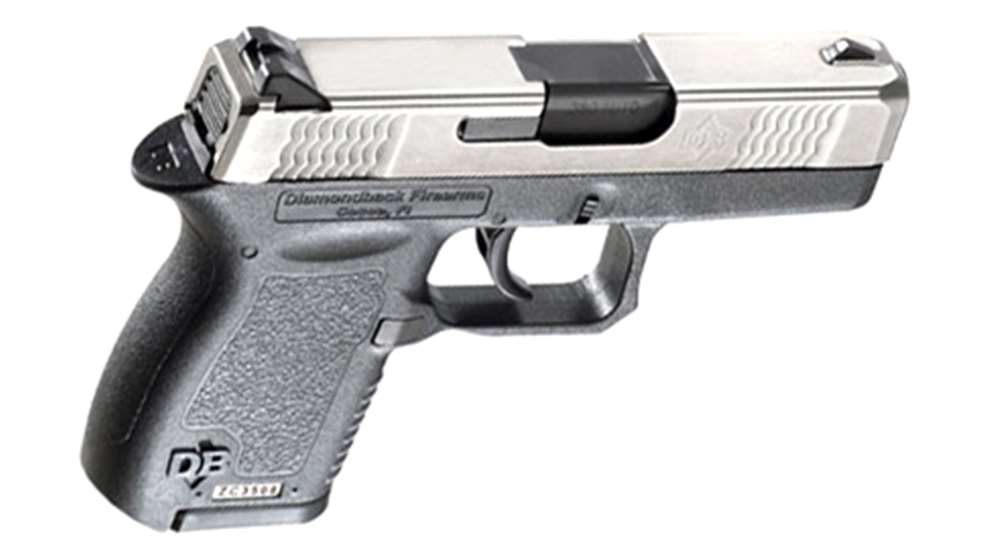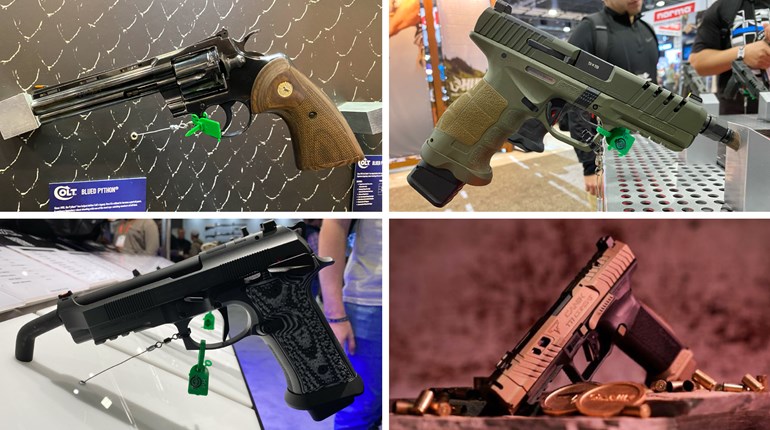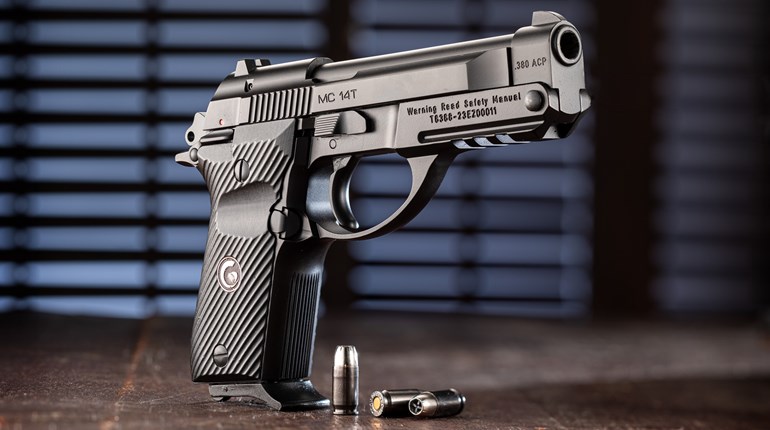
On a couple of occasions in the past, Shooting Illustrated contributors mentioned the importance of buying a gun that fits you. With the explosion of interest in pocket pistols generated by those who choose to carry concealed, it's time to re-examine exactly what we mean by the word "fit."
No, this is not going to be one of those classic, "It depends on what the definition of 'is' is," speeches. But as you downsize a handgun from the classic 1911's dimensions to something that will carry comfortably in your pocket, some things obviously have to change. The resulting firearm, if properly designed and built, will hide nicely in your pocket and still fit your hand well enough for you to protect yourself. To help illustrate this lesson, I've requested assistance from the Diamondback Firearms DB380, a new, double-action-only, striker-fired, semi-automatic pistol chambered in .380 ACP that does a nice job of filling the classic requirements of a pocket pistol.
Pocket pistols are manufactured to be as small as possible so you can easily carry them concealed. Generally speaking, the smaller the caliber and less powerful the cartridge, the smaller the pistol. This means they are a fraction the size of large, semi-automatic pistols typically chosen for concealed-carry purposes. While a modern .380 ACP pistol designed for concealed carry might fit the hand of an elf, it will be small for you.
Although the Diamondback DB380 is a tiny package, just about anyone should be able to effectively fire and control it. With its steel slide and barrel, and polymer frame, this little pistol weighs a mere 8.8 ounces, yet it has a 2.8-inch barrel—almost an inch longer than most popular pocket revolvers.
From front to back, the grip frame is longer than needed for the diminutive .380 ACP cartridge, and the backstrap is arched. Both these features help it fill the hand. The grip has a pebbled, grainy surface on the sides and eight rows of rather aggressive dimples on the frontstrap, resulting in a surface rough enough for good grip control, but not enough to catch on clothing when carried in a pocket. For added purchase, the face of the trigger guard has some gentle serrations in case your shooting grip includes placing a support finger there. The trigger guard provides ample access to the trigger, enabling you to position your trigger finger as you see fit, not as dictated by available space. One final nice touch of comfort you don't always see on pocket semi-autos is the understated beavertail that helped position my shooting hand and simultaneously prevented slide bite.
The DB380's slide is devoid of any extrusions, save the tiny assembly catch that sits in a pair of small dimples on each side of the frame. There is no external safety, nor does the slide lock back in the open position when the last round is fired. Disassembly requires both hands and a bit of dexterity, but no advanced degrees. It was fairly easy for me to release the catch and remove the slide, which means anyone should be able to do it.
Front and rear cocking serrations on the slide are not really serrations, but rather unidirectional, wave-shaped scallops. Grab the slide and push toward the rear, you have purchase; push toward the muzzle and you skim across the waves with no resistance.
Sights, as on most true pocket pistols, are not great, but the DB380's sights are better than most. Both front and rear sights are black, with the rear sight being dovetail-mounted and the front sight pinned. The rear sight is adjustable for windage. Small white dots are on each side of the rear-sight notch, while the front blade has a large white square. The difference in size between the dots and the square does good things for me. Without glasses, the fuzzy white square dominates the sight picture in dim light. Against a dark background, even when wearing glasses, I can't see daylight around the front sight blade, but the white marks remain clearly in focus. In short, the sights are usable and useful at the distances for which .380 ACP pistols were designed. They enabled me to put rounds into the vitals of a threat-size target.
As you would expect, the pointing characteristics of a pocket pistol are different than those in a full-size semi-automatic. What surprised me wasn't the difficulty in pointing the DB380, but rather how quickly I overcame that issue and adjusted to the new gun. Its slightly stretched grip frame (17⁄8 inches from backstrap to frontstrap) was probably the biggest contributor to my smooth transition. When I pushed the web of my hand into the baby beavertail and laid my trigger finger alongside the frame, the pistol rose from the holster to the firing position with the sights pretty well aligned on target.
The second major contribution to shooting success is the Diamondback's great trigger. The trigger pivots about a pin at its upper end and is connected to dual bars, which extend rearward along the inside of the frame. Trigger pull ran consistently right around 6 pounds, but it felt lighter due to smoothness and consistency throughout the stroke.
With a proper shooting grip, the trigger could be easily and repeatedly cycled with the pad of the trigger finger centered on the trigger, a matter I haven't found to be true on all pocket semi-automatics.
The trigger is single-strike; if the gun doesn't go bang, do a tap/rack and try again. The good news is the rack portion of the drill can be done safely and quickly on the small Diamondback due to the wave pattern on the slide. The bad news is the tap portion will take some retraining. Since only the middle and ring fingers of your shooting hand fit on the grip, your pinky and the bottom part of your palm prevents you from slapping the bottom of the magazine with your support hand. Whatever technique you use to initially seat the magazine when loading the gun should probably be duplicated in a modified tap/rack. This factor may be why some instructors favor carrying a backup pocket pistol rather than going for a reload. Also, natural dexterity quickly degrades at the sound of gunfire. As Winston Churchill said, "There is nothing more exhilarating than to be shot at without result!" He didn't say anything about incoming rounds improving one's coordination.
Personally, I would recommend getting an extra magazine and carrying it. Whether you choose to reload or grab a second gun, the six additional rounds are both easily carried and comforting.
It all came together when I took the pistol to the range. The Diamondback was totally manageable due to the nested recoil spring system and the smooth, consistent trigger pull. This "spring-in-a-spring" recoil system is being seen more and more in pocket pistols for one simple reason: It works well. Throw in the beautifully smooth trigger stroke, and the DB380 became a real confidence-builder.
The first session took place at an outdoor range and established the handgun's preference for lighter-weight bullets. Later I went to an indoor range, and while I kept the target out near the 10-yard mark, I moved it forward and backward slightly from reasonably well-lit locations to the darker, alley-like environment between the lights, the kind of environmentwhere a pocket pistol would most likely be needed.
The 80- to 90-grain ammunition I fed the DB380 (Remington 88-grain JHP, DoubleTap 80-grain TAC-XP and Winchester 88-grain JFP) worked without a hitch and produced groups ranging from 1 inch to 2.5 inches, depending on ambient light and how focused I stayed on the sight picture. The 90-grain loads from Cor-Bon, Hornady and Remington functioned most of the time with an occasional feeding hiccup, usually on the first round. Reliability became problematic with bullets heavier than 90 grains.
Interestingly, the gun shot all the ammunition into groups measuring 1 to 3 inches. I shot two groups of 12 rounds each with Remington 95-grain UMC Target and Hornady 90-grain Critical Defense loads, and both stayed inside 3 inches. With an adequate break-in period the Diamondback might reliably handle all weights of .380 ACP ammo, rather than just the lighter-weight bullets it liked in its opening sessions.
Overall fit and finish of the DB380 is very impressive. Lockup of the barrel/slide is precise, the large extractor fits beautifully into its slot in the slide with no rough edges, and the magazine slides smoothly into the magazine well, locking in place with a decisive and audible click.
Beauty may not be on the evaluation criteria list for a pocket pistol, but my wife did bestow the official "cute" title on the DB380 the first time she saw and handled it. I viewed the finished gun as something that will endure rough use and continue functioning as designed.
Combined with one of Galco's holsters, the DB380 makes an excellent security companion that will fit nicely in your trouser or jacket pockets or on your belt, while still fitting your hand well enough to empower you to deal with the perils of urban life. Now that's what I mean by a good "fit."





































